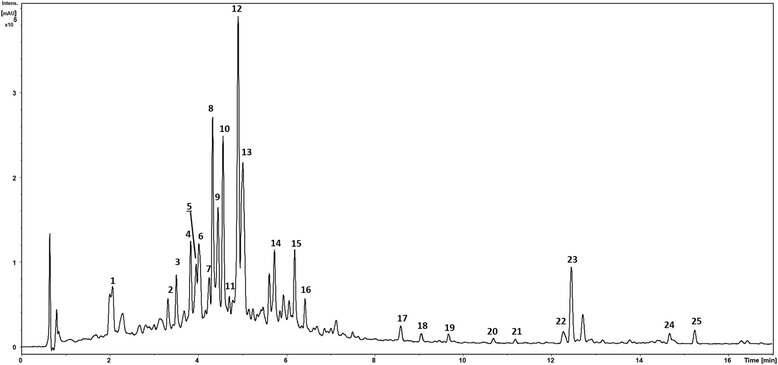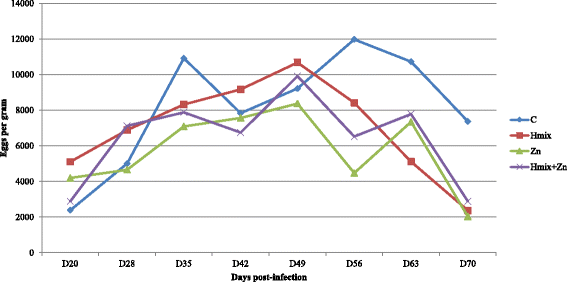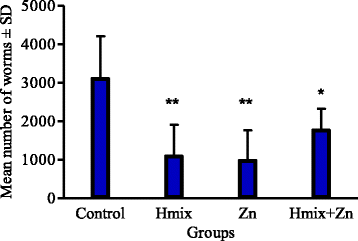Effects of herbal nutraceuticals and/or zinc against Haemonchus contortus in lambs experimentally infected
- PMID: 29523134
- PMCID: PMC5845177
- DOI: 10.1186/s12917-018-1405-4
Effects of herbal nutraceuticals and/or zinc against Haemonchus contortus in lambs experimentally infected
Abstract
Background: The gastrointestinal parasitic nematode Haemonchus contortus is a pathogenic organism resistant to several anthelmintics. This study assessed the efficacy of a medicinal herbal mixture (Herbmix) and organic zinc, as an essential trace element for the proper functioning of both unspecific and specific immune defensive mechanisms, against experimental infections with H. contortus in lambs. All lambs were infected orally with approximately 5000 third-stage larvae of a strain of H. contortus susceptible to anthelmintics (MHco1). Twenty-four female lambs 3-4 months of age were divided into four groups: unsupplemented animals (control), animals supplemented with Herbmix (Hmix), animals supplemented with organic zinc (Zn) and animals supplemented with Herbmix and organic zinc (Hmix+Zn). Eggs per gram (EPG) of faeces were quantified 20, 28, 35, 42, 49, 56, 62 and 70 d post-infection and mean abomasal worm counts were assessed 70 d post-infection. Samples of blood were collected from each animal 7, 35, 49 and 70 d post-infection.
Results: Quantitative analyses of the bioactive compounds in Herbmix identified three main groups: flavonoids (9964.7 μg/g), diterpenes (4886.1 μg/g) and phenolic acids (3549.2 μg/g). Egg counts in the lambs treated with Hmix, Zn and Hmix+Zn decreased after 49 d. The EPGs in the Zn and Hmix+Zn groups were significantly lower on day 56 (P < 0.05 and P < 0.01, respectively), and the EPGs and mean worm counts were significantly lower on day 70 in all supplemented groups (P < 0.05 and P < 0.01). Hemograms of complete red blood cells of each animal identified clinical signs of haemonchosis after day 35. Serum calprotectin concentrations and IgA levels were significantly affected by treatment. The treatment influenced serum malondialdehyde concentrations (P < 0.05) and sulfhydryl groups (P < 0.01) of antioxidant status. The mineral status was unaltered in all lambs.
Conclusion: A direct anthelmintic impact on the viability of nematodes was not fully demonstrated, but the treatments with herbal nutraceuticals and zinc likely indirectly contributed to the increase in the resistance of the lambs to nematode infection.
Keywords: Anthelmintic activity; Egg counts; Gastrointestinal nematode; Haemonchus contortus; Herbal bioactive compounds; Mineral status; Organic zinc; Sheep.
Conflict of interest statement
Ethics approval
Animal use and study design were approved by the Ethics Committee of the Institute of Parasitology of the Slovak Academy of Sciences in accordance with the national legislation in Slovakia - Animal Welfare Act No. 23/2009. Permission to collect study samples was granted by participating sheep farmers. The owner of the animals gave verbal consent to carry out of the experiment.
Consent for publication
Not applicable.
Competing interests
The authors declare that they have no competing interests.
Publisher’s Note
Springer Nature remains neutral with regard to jurisdictional claims in published maps and institutional affiliations.
Figures



Similar articles
-
Can the foregut nematode Haemonchus contortus and medicinal plants influence the fecal microbial community of the experimentally infected lambs?PLoS One. 2020 Jun 23;15(6):e0235072. doi: 10.1371/journal.pone.0235072. eCollection 2020. PLoS One. 2020. PMID: 32574178 Free PMC article.
-
Effect of zinc supplementation on ecto-adenosine deaminase activity in lambs infected by Haemonchus contortus: highlights on acute phase of disease.Exp Parasitol. 2015 Apr-May;151-152:34-8. doi: 10.1016/j.exppara.2015.01.010. Epub 2015 Jan 29. Exp Parasitol. 2015. PMID: 25639494
-
Natural chemotherapeutic alternatives for controlling of haemonchosis in sheep.BMC Vet Res. 2019 Aug 20;15(1):302. doi: 10.1186/s12917-019-2050-2. BMC Vet Res. 2019. PMID: 31429752 Free PMC article.
-
Diagnosis, Treatment and Management of Haemonchus contortus in Small Ruminants.Adv Parasitol. 2016;93:181-238. doi: 10.1016/bs.apar.2016.02.024. Epub 2016 May 10. Adv Parasitol. 2016. PMID: 27238006 Review.
-
Meta-analysis of the parasitic phase traits of Haemonchus contortus infection in sheep.Parasit Vectors. 2017 Apr 24;10(1):201. doi: 10.1186/s13071-017-2131-7. Parasit Vectors. 2017. PMID: 28438225 Free PMC article. Review.
Cited by
-
Antibody response and abomasal histopathology of lambs with haemonchosis during supplementation with medicinal plants and organic selenium.Vet Anim Sci. 2023 Feb 10;19:100290. doi: 10.1016/j.vas.2023.100290. eCollection 2023 Mar. Vet Anim Sci. 2023. PMID: 36845851 Free PMC article.
-
Does in Vitro and in Vivo Exposure To Medicinal Herbs Cause Structural Cuticular Changes in Haemonchus Contortus?Helminthologia. 2022 Dec 17;59(3):265-274. doi: 10.2478/helm-2022-0023. eCollection 2022 Sep. Helminthologia. 2022. PMID: 36694832 Free PMC article.
-
Does Herbal and/or Zinc Dietary Supplementation Improve the Antioxidant and Mineral Status of Lambs with Parasite Infection?Antioxidants (Basel). 2020 Nov 24;9(12):1172. doi: 10.3390/antiox9121172. Antioxidants (Basel). 2020. PMID: 33255492 Free PMC article.
-
Can the foregut nematode Haemonchus contortus and medicinal plants influence the fecal microbial community of the experimentally infected lambs?PLoS One. 2020 Jun 23;15(6):e0235072. doi: 10.1371/journal.pone.0235072. eCollection 2020. PLoS One. 2020. PMID: 32574178 Free PMC article.
-
Effects of Medicinal Plants and Organic Selenium against Ovine Haemonchosis.Animals (Basel). 2021 May 5;11(5):1319. doi: 10.3390/ani11051319. Animals (Basel). 2021. PMID: 34063070 Free PMC article.
References
-
- Kresánek J Jr, Kresánek J. Atlas of medicinal plants and berries, fourth ed. Osveta. Slovakia.
-
- Mali RG, Mehta AA. A review on anthelmintic plants. Nat Prod Rad. 2008;7:466–475.
-
- Andlauer W, Fürst P. Nutraceuticals: a piece of history, present status and outlook. Food Res Int. 2002;35:171–176. doi: 10.1016/S0963-9969(01)00179-X. - DOI
MeSH terms
Substances
LinkOut - more resources
Full Text Sources
Other Literature Sources
Medical
Miscellaneous

